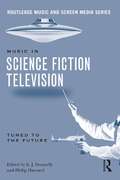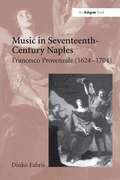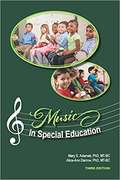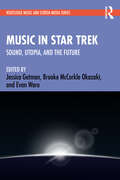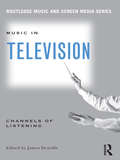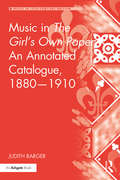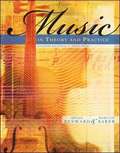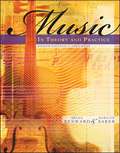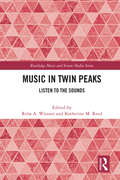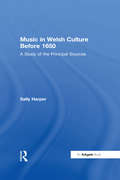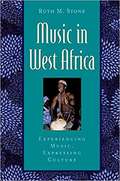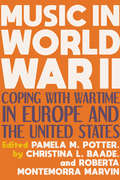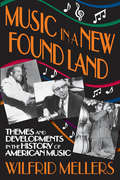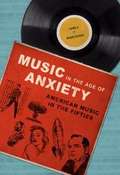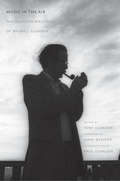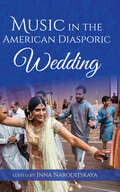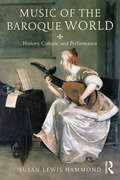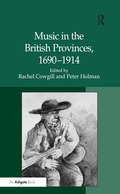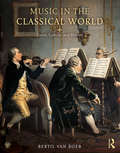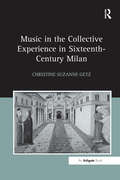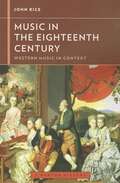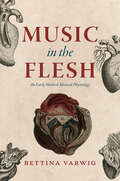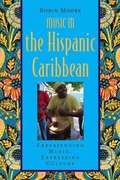- Table View
- List View
Music in Science Fiction Television: Tuned to the Future
by Philip Hayward K. J. DonnellyThe music for science fiction television programs, like music for science fiction films, is often highly distinctive, introducing cutting-edge electronic music and soundscapes. There is a highly particular role for sound and music in science fiction, because it regularly has to expand the vistas and imagination of the shows and plays a crucial role in setting up the time and place. Notable for its adoption of electronic instruments and integration of music and effects, science fiction programs explore sonic capabilities offered through the evolution of sound technology and design, which has allowed for the precise control and creation of unique and otherworldly sounds. This collection of essays analyzes the style and context of music and sound design in Science Fiction television. It provides a wide range of in-depth analyses of seminal live-action series such as Doctor Who, The Twilight Zone, and Lost, as well as animated series, such as The Jetsons. With thirteen essays from prominent contributors in the field of music and screen media, this anthology will appeal to students of Music and Media, as well as fans of science fiction television.
Music in Seventeenth-Century Naples: Francesco Provenzale (1624-1704)
by Dinko FabrisThe most important figure of seventeenth-century Neapolitan music, Francesco Provenzale (1624-1704) spent his long life in the service of a number of Neapolitan conservatories and churches, culminating in his appointment as maestro of the Tesoro di S. Gennaro and the Real Cappella. Provenzale was successful in generating significant profit from a range of musical activities promoted by him with the participation of his pupils and trusted collaborators. Dinko Fabris draws on newly discovered archival documents to reconstruct the career of a musician who became the leader of his musical world, despite his relatively small musical output. The book examines Provenzale's surviving works alongside those of his most important Neapolitan contemporaries (Raimo Di Bartolo, Sabino, Salvatore and Caresana) and pupils (Fago, Greco, Veneziano and many others), revealing both stylistic similarities and differences, particularly in terms of new harmonic practices and the use of Neapolitan language in opera. Fabris provides both a life and works study of Provenzale and a conspectus of Neapolitan musical life of the seventeenth century which so clearly laid the groundwork for Naples' later status as one of the great musical capitals of Europe.
Music in Special Education
by Mary Adamek Alice-Ann DarrowThe field of special education has changed greatly over the past four decades. With many of the changes, the responsibilities of music educators and music therapists have also changed. Music professionals in schools must keep abreast of related laws, terminologies, special education initiatives, and current instructional approaches, materials, and technologies in order to meet the needs of students with disabilities. Inclusive education has contributed to the changed roles of music therapists and music educators in the classroom. Music in Special Education (third edition) provides an introduction to the field of special education, and the current roles of music education and music therapy in the lives of students with disabilities and their families. <p><p> This updated edition of Music in Special Education explains important concepts in special education that are important for interdisciplinary communication and effective teamwork. Part I introduces the reader to the historical and instructional foundations of music in special education including major topics and developments in the field of special education, important terminology, and curricular issues. Part II introduces the characteristics of specific disabilities, the educational implications of these disabilities, appropriate instructional adaptations, as well as music education and music therapy approaches used with students who have these disabilities. Part III addresses the roles music educators and music therapists play in family and community lives of students with disabilities. <p> Music in Special Education (third edition) is an essential text to prepare effective future music educators and music therapists working in special education.
Music in Star Trek: Sound, Utopia, and the Future
by Jessica Getman Brooke McCorkle Okazaki Evan WareThe tensions between utopian dreams and dystopian anxieties permeate science fiction as a genre, and nowhere is this tension more evident than in Star Trek. This book breaks new ground by exploring music and sound within the Star Trek franchise across decades and media, offering the first sustained look at the role of music in shaping this influential series. The chapters in this edited collection consider how the aural, visual, and narrative components of Star Trek combine as it constructs and deconstructs the utopian and dystopian, shedding new light on the series’ political, cultural, and aesthetic impact. Considering how the music of Star Trek defines and interprets religion, ideology, artificial intelligence, and more, while also considering fan interactions with the show’s audio, this book will be of interest to students and scholars of music, media studies, science fiction, and popular culture.
Music in Television: Channels of Listening
by James DeavilleMusic in Television is a collection of essays examining television’s production of meaning through music in terms of historical contexts, institutional frameworks, broadcast practices, technologies, and aesthetics. It presents the reader with overviews of major genres and issues, as well as specific case studies of important television programs and events. With contributions from a wide range of scholars, the essays range from historical-analytical surveys of TV sound and genre designations to studies of the music in individual programs, including South Park and Dr. Who.
Music in The Girl's Own Paper: An Annotated Catalogue, 1880-1910 (Music in Nineteenth-Century Britain)
by Judith BargerNineteenth-century British periodicals for girls and women offer a wealth of material to understand how girls and women fit into their social and cultural worlds, of which music making was an important part. The Girl's Own Paper, first published in 1880, stands out because of its rich musical content. Keeping practical usefulness as a research tool and as a guide to further reading in mind, Judith Barger has catalogued the musical content found in the weekly and later monthly issues during the magazine's first thirty years, in music scores, instalments of serialized fiction about musicians, music-related nonfiction, poetry with a musical title or theme, illustrations depicting music making and replies to musical correspondents. The book's introductory chapter reveals how content in The Girl's Own Paper changed over time to reflect a shift in women's music making from a female accomplishment to an increasingly professional role within the discipline, using 'the piano girl' as a case study. A comparison with musical content found in The Boy's Own Paper over the same time span offers additional insight into musical content chosen for the girls' magazine. A user's guide precedes the chronological annotated catalogue; the indexes that follow reveal the magazine's diversity of approach to the subject of music.
Music in Theory and Practice, Volume 1 (8th edition)
by Bruce Benward Marilyn SakerThis best-selling text gives majors a solid foundation in the theory of music - generally and throughout history. It strengthens their musical intuition, builds technical skills, and helps them gain interpretive insights. The two-volume format ensures exhaustive coverage and maximum support for students and faculty alike. Volume I serves as a general introduction to music theory while volume II offers a survey of the theoretical underpinnings of musical styles and forms from Gregorian Chant through the present day.
Music in Theory and Practice, Volume 2 (8th edition)
by Bruce Benward Marilyn SakerThis best-selling text gives majors a solid foundation in the theory of music - generally and throughout history. It strengthens their musical intuition, builds technical skills, and helps them gain interpretive insights. The two-volume format ensures exhaustive coverage and maximum support for students and faculty alike. Volume I serves as a general introduction to music theory while volume II offers a survey of the theoretical underpinnings of musical styles and forms from Gregorian Chant through the present day.
Music in Twin Peaks: Listen to the Sounds
by Katherine M. ReedIn this edited volume, contributors explore an essential element of the influential television series Twin Peaks: the role of music and sound. From its debut in 1990 to its return to television in 2017, Twin Peaks has amassed a cult following, and inspired myriad scholarly studies. This collection considers how the music and sound design not only create the ambience of this ground-breaking series, but function in the narrative, encouraging multiple interpretations. With chapters that consider how music shapes the relationship of audiences and fans to the story, the importance of sound design, and the symbolism embedded in the score, this book provides a range of perspectives for scholars of music and film studies, while giving fans new insight into an iconic television show.
Music in Twin Peaks: Listen to the Sounds (Routledge Music and Screen Media Series)
by Katherine M. ReedIn this edited volume, contributors explore an essential element of the influential television series Twin Peaks: the role of music and sound. From its debut in 1990 to its return to television in 2017, Twin Peaks has amassed a cult following, and inspired myriad scholarly studies. This collection considers how the music and sound design not only create the ambience of this ground-breaking series, but function in the narrative, encouraging multiple interpretations. With chapters that consider how music shapes the relationship of audiences and fans to the story, the importance of sound design, and the symbolism embedded in the score, this book provides a range of perspectives for scholars of music and film studies, while giving fans new insight into an iconic television show.
Music in Welsh Culture Before 1650: A Study of the Principal Sources
by Sally HarperMusic in Wales has long been a neglected area. Scholars have been deterred both by the need for a knowledge of the Welsh language, and by the fact that an oral tradition in Wales persisted far later than in other parts of Britain, resulting in a limited number of sources with conventional notation. Sally Harper provides the first serious study of Welsh music before 1650 and draws on a wide range of sources in Welsh, Latin and English to illuminate early musical practice. This book challenges and refutes two widely held assumptions - that music in Wales before 1650 is impoverished and elusive, and that the extant sources are too obscure and fragmentary to warrant serious study. Harper demonstrates that there is a far wider body of source material than is generally realized, comprising liturgical manuscripts, archival materials, chronicles and retrospective histories, inventories of pieces and players, vernacular poetry and treatises. This book examines three principal areas: the unique tradition of cerdd dant (literally 'the music of the string') for harp and crwth; the Latin liturgy in Wales and its embellishment, and 'Anglicised' sacred and secular materials from c.1580, which show Welsh music mirroring English practice. Taken together, the primary material presented in this book bears witness to a flourishing and distinctive musical tradition of considerable cultural significance, aspects of which have an important impact on wider musical practice beyond Wales.
Music in West Africa
by Ruth M. StoneMusic in West Africa is one of several case-study volumes that can be used along with Thinking Musically, the core book in the Global Music Series. Thinking Musically incorporates music from many diverse cultures and establishes the framework for exploring the practice of music around the world. It sets the stage for an array of case-study volumes, each of which focuses on a single area of the world. Each case study uses the contemporary musical situation as a point of departure, covering historical information and traditions as they relate to the present. Visit www.oup.com/us/globalmusic for a list of case studies in the Global Music Series. The website also includes instructional materials to accompany each study. Music in West Africa presents fundamental style concepts of West African music using a focused case study of performance in Liberia, West Africa, among the Kpelle people. The book discusses the diversity, motifs, and structure of West African music within the larger patterns of the region's culture, highlighting those aspects of Kpelle music that are common to many other West African traditions. It also describes how music and dance in West Africa are tied to the fabric of everyday social and political life.<P><P> Kpelle musicians value musical performance where multiple performers each contribute aspects of sound that fit together in elaborate ways. Drawing upon her extensive fieldwork and research, author Ruth Stone--who was raised in the Bong County region of Liberia--centers on key stylistic elements that Kpelle performers articulate and emphasize: faceting or breaking music into smaller parts, layering tone colors, part-counterpart relationships in musical structures, and time and polyrhythm. She explores fascinating parallels to these analytic themes in the textiles and masks of related arts and in broader cultural practices such as greeting sequences.<P><P> Music in West Africa is enhanced by eyewitness accounts of local performances, interviews with key performers, and vivid illustrations. Packaged with a 70-minute CD containing examples of the music discussed in the book, it features guided listening and hands-on activities that encourage readers to engage actively and critically with the music.
Music in World War II: Coping with Wartime in Europe and the United States
by Pamela M. Potter, Christina L. Baade, and Roberta Montemorra MarvinA collection of essays examining the roles played by music in American and European society during the Second World War.Global conflicts of the twentieth century fundamentally transformed not only national boundaries, power relations, and global economies, but also the arts and culture of every nation involved. An important, unacknowledged aspect of these conflicts is that they have unique musical soundtracks. Music in World War II explores how music and sound took on radically different dimensions in the United States and Europe before, during, and after World War II. Additionally, the collection examines the impact of radio and film as the disseminators of the war’s musical soundtrack. Contributors contend that the European and American soundtrack of World War II was largely one of escapism rather than the lofty, solemn, heroic, and celebratory mode of “war music” in the past. Furthermore, they explore the variety of experiences of populations forced from their homes and interned in civilian and POW camps in Europe and the United States, examining how music in these environments played a crucial role in maintaining ties to an idealized “home” and constructing politicized notions of national and ethnic identity. This fascinating, well-constructed volume of essays builds understanding of the role and importance of music during periods of conflict and highlights the unique aspects of music during World War II.“A collection that offers deeply informed, interdisciplinary, and original views on a myriad of musical practices in Europe, Great Britain, and the United States during the period.” —Gayle Magee, co-editor of Over Here, Over There: Transatlantic Conversations on the Music of World War I
Music in a New Found Land: Themes and Developments in the History of American Music
by Manfred HolthusThe subject of this book is accurately defined by its subtitle. Music in a New Found Land does not pretend to be a comprehensive history of American music. Nor does Mellers strive to catalog what he considers to be authentic American music. Instead, he deals, in some detail, with comparatively few composers, most of whom have wellestablished reputations.It has always been difficult to separate American music from its immediate relevance to the twentieth century. Mellers' theme involves the relationship between "art" music, jazz and pop music; he sees the segregation of these genres as both illogical and artifi cial. If the pop music of Tin Pan Alley may be anti-art, it has also produced Gershwin, Ellington, and composing improvisers such as Louis Armstrong, Charlie Parker, and Miles Davis.The study of American music is as relevant into any inquiry into a national culture as the study of American literature and painting. This book contains a large number of quotations from American writers, because Mellers thought American sensibility should parallel, reinforce, and comment on American music. In sum, this is the closest available one-volume history of American music, and a window into American culture.
Music in the Age of Anxiety: American Music in the Fifties
by James WierzbickiDerided for its conformity and consumerism, 1950s America paid a price in anxiety. Prosperity existed under the shadow of a mushroom cloud. Optimism wore a Bucky Beaver smile that masked worry over threats at home and abroad. But even dread could not quell the revolutionary changes taking place in virtually every form of mainstream music. Music historian James Wierzbicki sheds light on how the Fifties' pervasive moods affected its sounds. Moving across genres established--pop, country, opera--and transfigured--experimental, rock, jazz--Wierzbicki delves into the social dynamics that caused forms to emerge or recede, thrive or fade away. Red scares and white flight, sexual politics and racial tensions, technological progress and demographic upheaval--the influence of each rooted the music of this volatile period to its specific place and time. Yet Wierzbicki also reveals the host of underlying connections linking that most apprehensive of times to our own uneasy present.
Music in the Air: The Selected Writings of Ralph J. Gleason
by Jann Wenner Paul Scanlon Ralph J. Gleason Toby GleasonThe co-founder of Rolling Stone magazine, Ralph J. Gleason was among the most respected journalists, interviewers, and critics writing about popular music in the latter half of the twentieth century. As a longtime contributor to the San Francisco Chronicle, Down Beat, and Ramparts, his expertise and insights about music, musicians, and cultural trends were unparalleled, whether his subject was jazz, folk, pop, or rock and roll. He was the only music journalist included on President Richard Nixon's infamous "Enemies List," which Gleason himself considered "the highest honor a man's country can bestow upon him. " This sterling anthology, edited by Gleason's son Toby, himself a forty-year veteran of the music business, spans Ralph J. Gleason's four decades as popular music's preeminent commentator. Drawing from a rich variety of sources, including Gleason's books, essays, interviews, and LP record album liner notes, it is essential reading for writers, historians, scholars, and music lovers of every stripe.
Music in the American Diasporic Wedding
by Edited by Inna NaroditskayaWith real-life stories, this collection “focuses on the role of music in the often-delicate negotiations surrounding weddings in immigrant communities” (Ellen Koskoff, author of A Feminist Ethnomusicology).Music in the American Diasporic Wedding explores the complex cultural adaptations, preservations, and fusions that occur in weddings between couples and families of diverse origins. Discussing weddings as a site of negotiations between generations, traditions, and religions, the essays gathered here argue that music is the mediating force between the young and the old, ritual and entertainment, and immigrant lore and assimilation.The contributors examine such colorful integrations as klezmer-tinged Mandarin tunes at a Jewish and Taiwanese American wedding, a wedding services industry in Chicago’s South Asian community featuring a diversity of wedding music options, and Puerto Rican cultural activists dancing down the aisles of New York’s St. Cecilia’s church to the thunder of drums and maracas and rapping their marriage vows. These essays show us what wedding music and performance tell us about complex multiethnic diasporic identities, and remind us that how we listen to and celebrate otherness defines who we are.
Music in the American Diasporic Wedding
by Edited by Inna NaroditskayaWith real-life stories, this collection “focuses on the role of music in the often-delicate negotiations surrounding weddings in immigrant communities” (Ellen Koskoff, author of A Feminist Ethnomusicology).Music in the American Diasporic Wedding explores the complex cultural adaptations, preservations, and fusions that occur in weddings between couples and families of diverse origins. Discussing weddings as a site of negotiations between generations, traditions, and religions, the essays gathered here argue that music is the mediating force between the young and the old, ritual and entertainment, and immigrant lore and assimilation.The contributors examine such colorful integrations as klezmer-tinged Mandarin tunes at a Jewish and Taiwanese American wedding, a wedding services industry in Chicago’s South Asian community featuring a diversity of wedding music options, and Puerto Rican cultural activists dancing down the aisles of New York’s St. Cecilia’s church to the thunder of drums and maracas and rapping their marriage vows. These essays show us what wedding music and performance tell us about complex multiethnic diasporic identities, and remind us that how we listen to and celebrate otherness defines who we are.
Music in the Baroque World: History, Culture, and Performance
by Susan Lewis HammondMusic in the Baroque World: History, Culture, Performance offers an interdisciplinary study of the music of Europe and the Americas in the seventeenth and first half of the eighteenth centuries. It answers calls for an approach that balances culture, history, and musical analysis, with an emphasis on performance considerations such as notation, instruments, and performance techniques. It situates musical events in their intellectual, social, religious, and political contexts and enables in-depth discussion and critical analysis. Features: An interdisciplinary approach that balances detailed analysis of specific pieces of music and broader historical overview and relevance A selection of historical documents at the end of each chapter that position musical works and events in their cultural context Extensive musical examples that show the melodic, textural, harmonic, or structural features of baroque music and enhance the utility of the textbook for undergraduate and graduate music majors A global perspective with a chapter on Music in the Americas A companion score anthology and website with links to audio/video content of key performances and research and writing guides Music in the Baroque World: History, Culture, Performance tells stories of local traditions, cultural exchange, performance trends, and artistic mixing. It illuminates representative works through the lens of politics, visual arts, theology, print culture, gender, domesticity, commerce, and cultural influence and exchange.
Music in the British Provinces, 1690-1914
by Peter HolmanThe period covered by this volume, roughly from Purcell to Elgar, has traditionally been seen as a dark age in British musical history. Much has been done recently to revise this view, though research still tends to focus on London as the commercial and cultural hub of the British Isles. It is becoming increasingly clear, however, that by the mid-eighteenth century musical activity outside London was highly distinctive in terms of its reach, the way it was organized, and its size, richness, and quality. There was an extraordinary amount of musical activity of all sorts, in provincial theatres and halls, in the amateur orchestras and choirs that developed in most towns of any size, in taverns, and convivial clubs, in parish churches and dissenting chapels, and, of course, in the home. This is the first book to concentrate specifically on musical life in the provinces, bringing together new archival research and offering a fresh perspective on British music of the period. The essays brought together here testify to the vital role played by music in provincial culture, not only in socializing and networking, but in regional economies and rivalries, demographics and class dynamics, religion and identity, education and recreation, and community and the formation of tradition. Most important, perhaps, as our focus shifts from London to the regions, new light is shed on neglected figures and forgotten repertoires, all of them worthy of reconsideration.
Music in the Classical World: Genre, Culture, and History
by Bertil Van BoerMusic in the Classical World: Genre, Culture, and History provides a broad sociocultural and historical perspective of the music of the Classical Period as it relates to the world in which it was created. It establishes a background on the time span—1725 to 1815—offering a context for the music made during one of the more vibrant periods of achievement in history. Outlining how music interacted with society, politics, and the arts of that time, this kaleidescopic approach presents an overview of how the various genres expanded during the period, not just in the major musical centers but around the globe. Contemporaneous treatises and commentary documenting these changes are integrated into the narrative. Features include the following: A complete course with musical scores on the companion website, plus links to recordings—and no need to purchase a separate anthology The development of style and genres within a broader historical framework Extensive musical examples from a wide range of composers, considered in context of the genre A thorough collection of illustrations, iconography, and art relevant to the music of the age Source documents translated by the author Valuable student learning aids throughout, including a timeline, a register of people and dates, sidebars of political importance, and a selected reading list arranged by chapter and topic A companion website featuring scores of all music discussed in the text, recordings of most musical examples, and tips for listening Music in the Classical World: Genre, Culture, and History tells the story of classical music through eighteenth-century eyes, exposing readers to the wealth of music and musical styles of the time and providing a glimpse into that vibrant and active world of the Classical Period.
Music in the Collective Experience in Sixteenth-Century Milan
by Christine Suzanne GetzRenaissance music, like its sister arts, was most often experienced collectively. While it was possible to read Renaissance polyphony silently from a music manuscript or print, improvise alone, or perform as a soloist, the very practical nature of Renaissance music defied individualism. The reading and improvisation of polyphony was most frequently achieved through close co-operation, and this mutual endeavour extended beyond the musicians to include the society to which it is addressed. In sixteenth-century Milan, music, an art traditionally associated with the court and cathedral, came to be appropriated by the old nobility and the new aristocracy alike as a means of demonstrating social primacy and newly acquired wealth. As class mobility assumed greater significance in Milan and the size of the city expanded beyond its Medieval borders, music-making became ever more closely associated with public life. With its novel structures and diverse urban spaces, sixteenth-century Milan offered an unlimited variety of public performance arenas. The city's political and ecclesiastical authorities staged grand processions, church services, entertainments, and entries aimed at the propagation of both church and state. Yet the private citizen utilized such displays as well, creating his own miniature spectacle in a visual and an aural imitation of the ecclesiastical and political panoply of the age. Using archival documents, music prints, manuscripts and contemporary writing, Getz examines the musical culture of sixteenth-century Milan via its life within the city's most influential social institutions to show how fifteenth-century courtly traditions were adapted to the public arena. The book considers the relationship of the primary cappella musicale, including those of the Duomo, the court of Milan, Santa Maria della Scala, and Santa Maria presso San Celso, to the sixteenth-century institutions that housed them. In addition, the book investigates the musician's role as an actor and a functionary in the political, religious, and social spectacles produced by the Milanese church, state, and aristocracy within the city's diverse urban spaces. Furthermore, it establishes a context for the numerous motets, madrigals, and lute intabulations composed and printed in sixteenth-century Milan by examining their function within the urban milieu in which they were first performed. Finally, it musically documents Milan's transformation from a ducal state dominated by provincial traditions into a mercantile centre of international acclaim. Such an important study in Italian Renaissance music will therefore appeal to anyone interested in the culture of Renaissance Italy.
Music in the Eighteenth Century (Western Music in Context: A Norton History)
by John A. RiceJohn Rice's Music in the Eighteenth Century takes the reader on an engrossing Grand Tour of Europe's musical centers, from Naples, to London, Berlin, Vienna, Prague, and St. Petersburg ―with a side trip to the colonial New World. Against the backdrop of Europe's largely peaceful division into Catholic and Protestant realms, Rice shows how "learned" and "galant" styles developed and commingled. While considering Mozart, Haydn, and early Beethoven in depth, he broadens his focus to assess the contributions of lesser-known but significant figures like Johann Adam Hiller, Francois-André Philidor, and Anna Bon. Western Music in Context: A Norton History comprises six volumes of moderate length, each written in an engaging style by a recognized expert. Authoritative and current, the series examines music in the broadest sense―as sounds notated, performed, and heard―focusing not only on composers and works, but also on broader social and intellectual currents.
Music in the Flesh: An Early Modern Musical Physiology (New Material Histories of Music)
by Bettina VarwigA corporeal history of music-making in early modern Europe. Music in the Flesh reimagines the lived experiences of music-making subjects—composers, performers, listeners—in the long seventeenth century. There are countless historical testimonies of the powerful effects of music upon the early modern body; it is described as moving, ravishing, painful, dangerous, curative, and miraculous while affecting “the circulation of the humors, the purification of the blood, the dilation of the vessels and pores.” How were these early modern European bodies constituted that music generated such potent bodily-spiritual effects? Bettina Varwig argues that early modern music-making practices challenge our modern understanding of human nature as a mind-body dichotomy. Instead, they persistently affirm a more integrated anthropology, in which body, soul, and spirit remain inextricably entangled. Moving with ease across repertories and regions, sacred and vernacular musics, and domestic and public settings, Varwig sketches a “musical physiology” that is as historically illuminating as it is relevant for present-day performance. This book makes a significant contribution not just to the history of music, but also to the history of the body, the senses, and the emotions, revealing music as a unique access point for reimagining early modern modes of being-in-the-world.
Music in the Hispanic Caribbean: Experiencing Music, Expressing Culture (Global Music Series)
by Robin MooreThe Spanish-speaking islands of Cuba, Puerto Rico, and the Dominican Republic make up a relatively small region, but their musical and cultural traditions have had a dramatic, sweeping impact on the world. This brief volume provides the reader with an introduction to the music of Cuba, Puerto Rico, and the Dominican Republic, as well as to various common themes and tendencies that have informed music making in those countries. The text provides a vibrant introduction to diverse musical styles including salsa, merengue, reggaeton, plena, Latin jazz, and the bolero. A comparative approach of writing about the three countries together helps us to think of the Hispanic Caribbean as an interconnected whole. A compelling, comprehensive review, Music in the Hispanic Caribbean is ideal for introductory undergraduate courses in world music or ethnomusicology and for upper-level courses on Caribbean and Latin American music and/or culture.
